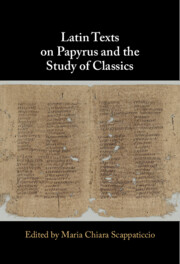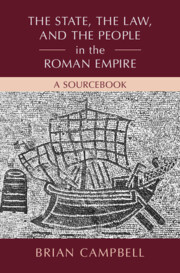Refine search
Actions for selected content:
24162 results in Ancient history
Chapter 6 - Gregory’s Veils
-
- Book:
- Veiling in the Late Antique World
- Published online:
- 26 November 2025
- Print publication:
- 18 December 2025, pp 215-240
-
- Chapter
- Export citation
Acknowledgments
-
- Book:
- Veiling in the Late Antique World
- Published online:
- 26 November 2025
- Print publication:
- 18 December 2025, pp xii-xiv
-
- Chapter
- Export citation
Abbreviations
-
- Book:
- Veiling in the Late Antique World
- Published online:
- 26 November 2025
- Print publication:
- 18 December 2025, pp xv-xvi
-
- Chapter
- Export citation
Copyright page
-
- Book:
- Veiling in the Late Antique World
- Published online:
- 26 November 2025
- Print publication:
- 18 December 2025, pp iv-iv
-
- Chapter
- Export citation
Chapter 1 - Veiling in the Ancient Mediterranean
-
- Book:
- Veiling in the Late Antique World
- Published online:
- 26 November 2025
- Print publication:
- 18 December 2025, pp 19-69
-
- Chapter
- Export citation
Chapter 3 - Women’s Veiling Practices in Late Antiquity
-
- Book:
- Veiling in the Late Antique World
- Published online:
- 26 November 2025
- Print publication:
- 18 December 2025, pp 90-143
-
- Chapter
- Export citation
Introduction
-
- Book:
- Veiling in the Late Antique World
- Published online:
- 26 November 2025
- Print publication:
- 18 December 2025, pp 1-18
-
- Chapter
- Export citation

Latin Texts on Papyrus and the Study of Classics
-
- Published online:
- 12 December 2025
- Print publication:
- 08 January 2026

The State, the Law, and the People in the Roman Empire
- A Sourcebook
-
- Published online:
- 11 December 2025
- Print publication:
- 11 December 2025
Additional material
-
- Book:
- The State, the Law, and the People in the Roman Empire
- Published online:
- 11 December 2025
- Print publication:
- 11 December 2025, pp xviii-xxii
-
- Chapter
- Export citation
Chapter 7 - Appearing in Court
-
- Book:
- The State, the Law, and the People in the Roman Empire
- Published online:
- 11 December 2025
- Print publication:
- 11 December 2025, pp 347-412
-
- Chapter
- Export citation
Chapter 6 - Crime and Punishment
-
- Book:
- The State, the Law, and the People in the Roman Empire
- Published online:
- 11 December 2025
- Print publication:
- 11 December 2025, pp 278-346
-
- Chapter
- Export citation
Chapter 11 - Prayer
- from Part II - Beliefs and Practices
-
-
- Book:
- Personal Religion in the Ancient Greek World
- Published online:
- 25 November 2025
- Print publication:
- 11 December 2025, pp 251-270
-
- Chapter
- Export citation
Chapter 14 - Herodotus
- from Part III - Individuals
-
-
- Book:
- Personal Religion in the Ancient Greek World
- Published online:
- 25 November 2025
- Print publication:
- 11 December 2025, pp 321-337
-
- Chapter
- Export citation
Contents
-
- Book:
- The State, the Law, and the People in the Roman Empire
- Published online:
- 11 December 2025
- Print publication:
- 11 December 2025, pp vii-xi
-
- Chapter
- Export citation
Bibliography
-
- Book:
- Personal Religion in the Ancient Greek World
- Published online:
- 25 November 2025
- Print publication:
- 11 December 2025, pp 467-535
-
- Chapter
- Export citation
Chapter 5 - Government, Citizens, and Property
-
- Book:
- The State, the Law, and the People in the Roman Empire
- Published online:
- 11 December 2025
- Print publication:
- 11 December 2025, pp 229-277
-
- Chapter
- Export citation
Chapter 9 - Oracles and Divination
- from Part II - Beliefs and Practices
-
-
- Book:
- Personal Religion in the Ancient Greek World
- Published online:
- 25 November 2025
- Print publication:
- 11 December 2025, pp 211-231
-
- Chapter
- Export citation
Chapter 6 - Personal Religion and Old Comedy
- from Part I - Contexts and Perspectives
-
-
- Book:
- Personal Religion in the Ancient Greek World
- Published online:
- 25 November 2025
- Print publication:
- 11 December 2025, pp 141-164
-
- Chapter
- Export citation
Part I - Contexts and Perspectives
-
- Book:
- Personal Religion in the Ancient Greek World
- Published online:
- 25 November 2025
- Print publication:
- 11 December 2025, pp 25-164
-
- Chapter
- Export citation
